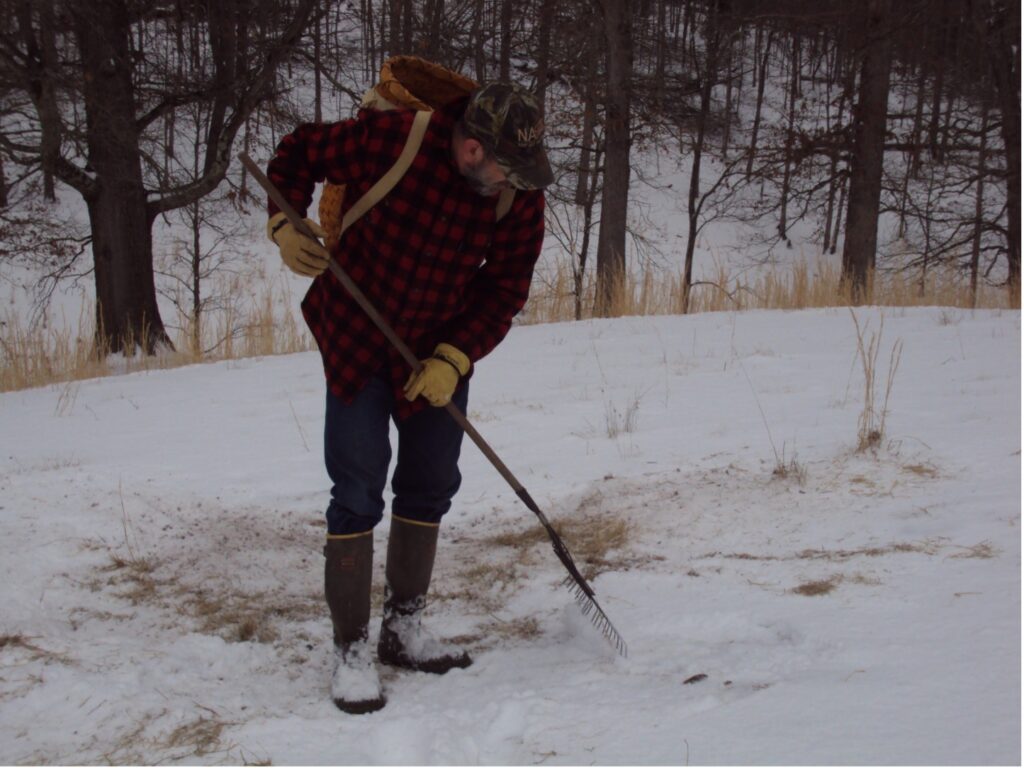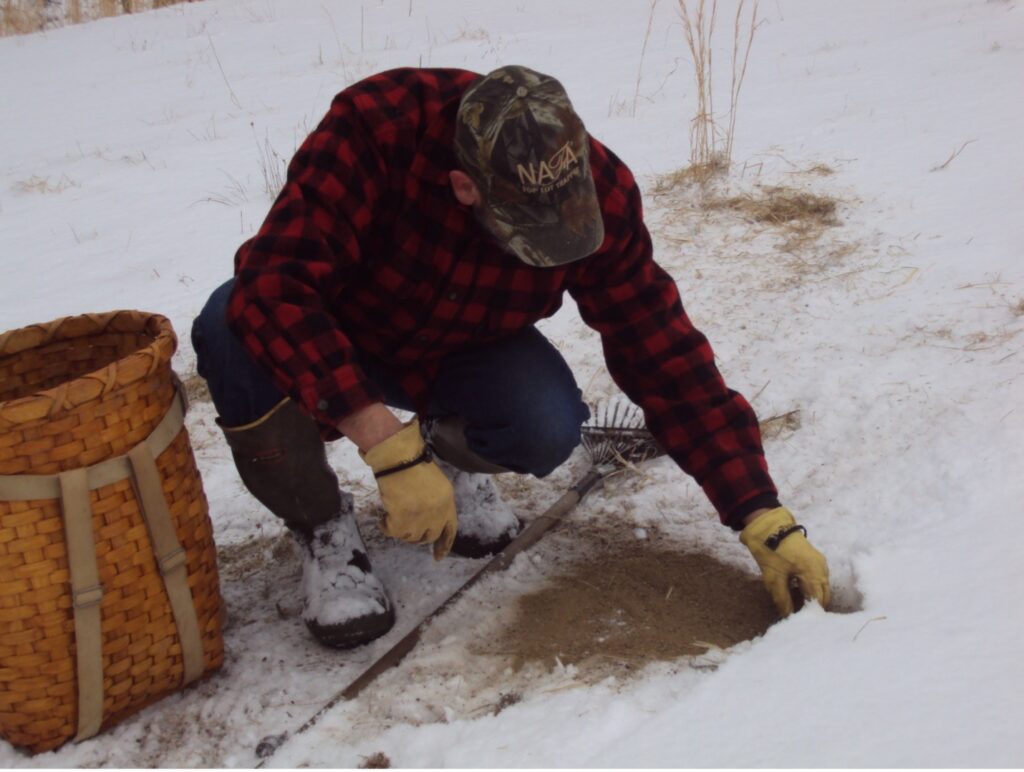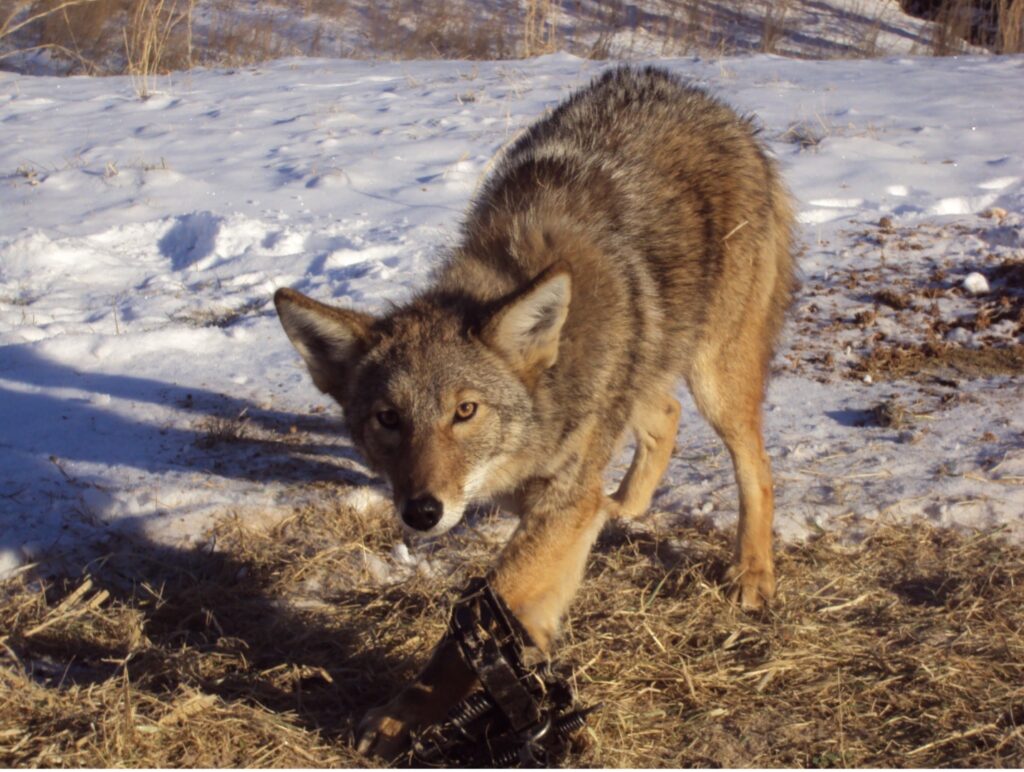Every trapper has his favorite tools of the trade. Some folks are gadget happy and probably have more tools than they should. Others are real minimalists and hardly carry more than a digging tool. Wherever a trapper falls on that continuum, most all appreciate tools that get the job done. I am one who has simplified my trapping tools and methods over the years, but when the snow arrives I throw one more tool in the truck: my steel-tined leaf rake.

Snow is one of those added burdens on the predator trapline which must be managed. I have found a steel-tined leaf rake to be one of the handiest tools for moving snow. It is great for cleaning light snow accumulations off sets, blending in sets, and even as a drag to blot out your tracks. I have always used a rake with fine spring steel tines. A plastic leaf rake might work, but I feel the fine steel tines leave a much more natural looking disturbance when cleaning off the set area.
I have trapped predators in northern and southeastern Pennsylvania, Virginia, and West Virginia. At these middle latitudes, most of the time, set maintenance only requires dealing with two to six inches of new snow fall. That amount of snow, as long as it isn’t the heavy wet stuff, can be moved quite easily with a leaf rake. If a really big storm dumps a pile of snow, a scoop shovel might be required to clean off sets, but day-to-day I find my leaf rake just the ticket.
After a snow, I approach my trap location and begin by finding the set or sets. During the winter, I try to use enough backing to easily locate the set after a snow. If such is not possible, I will transplant a woody weed nearby to help my failing mind. I first rake the snow down to ground level a couple feet back from the set to have a place to stand and to sit down my gear. This also keeps me from packing down the snow. The next thing I do is gently clean off the trap bed. Here is where one can easily snap the trap if you rake too deep, so I often just use my gloved hand to sweep off the trap bed. A whisk broom would be a handy alternative, but I rarely carry one. Once I have the trap bed cleared, I begin raking snow away from the set in a circular fashion to create the appearance of a catch circle. Without over doing it, I use the leaf rake to kick snow, grass, and dirt back from the set for four to six feet in all directions, being careful to preserve my set backing. I like the eye appeal this creates. This raked area not only looks like a catch circle, but also looks similar to areas where deer and livestock have foraged. Usually the wind works with me to lightly dust the area with blowing snow over the next few hours to produce a nice blended look. Sometimes the wind overdoes it, and the next day I have to clean the set off again.

The raking of the set area usually creates a well-blended look. However, often the dry dirt in my trap bed is a bit of a stand out. Usually a little wind will produce a slight topping of snow over the trap bed before night fall. If it is a calm day or the set is in a spot protected from the wind such as a location in the woods, I find another use for my leaf rake. Snow is very fickle and is a poor trap covering. Moving or handling snow often causes it to crust. To simply top dress a set with a dusting of snow, I again use my leaf rake. I use the long handle of the rake to reach the lightest snow I can see and flick small amounts toward the set. I try to give the snow a little elevation on its journey toward my trap bed. This serves two purposes. First, it spreads the snow particles out to produce just a dusting, but most importantly, it keeps the snow dry and reduces the chance of crusting. Even still, I try to never blend more than just a dusting of snow over the set and, when given the chance, prefer that Mother Nature do the work for me.
Putting In New Trap Sets In The Snow
When putting in new sets, I use basically the same procedure. I try and pick sites by paying attention to how the snow is drifting and, if possible, select an area which will tend to blow clear of snow. Looking for those natural wind-blown locations is one of the secrets of winter trapping. Generally what is going to make a good backing for my set will stand out even with several inches of snow on the ground. I clean off the area around the set backing with my leaf rake creating that catch circle look. As I orient my set against the backing, I try to take into account the wind direction. During the winter, I am not only concerned with the set being properly oriented so the lure will draw the fox or coyote over the trap. I am also conscious of any guides or obstructions near the trap which might create a mini-drift right on top of my trap bed. I will re-arrange these guides or remove them if they are causing drifting issues over the trap.

As I have mentioned, the rake is also great for brushing out your tracks in the snow. I don’t know what fox and coyotes really think about human foot prints in the snow. I suspect they are not really afraid of them. I have many times seen where they have followed my foot prints from the day before. It is opinion among many trappers that stopping and tramping around in the snow will cause some fox and coyote to detour around the area. Here is another great situation to call on the services of the humble steel-tined leaf rake. I find my leaf rake provides a wonderful way of dealing with my foot-prints in the snow. It is both a very effective and a lightweight drag for blotting out my tracks. Snow country trappers have often noted how fox, coyotes and bobcats follow snowmobile tracks. I have observed where the leaf rake drag produces similar results, with predators often following the drag mark for a number of yards. I like to take advantage of this by beginning to drag the leaf rake behind me well before I approach my set. After tending to my set, I continue this drag mark through and beyond the location. Does this catch me more fur? I don’t know, but it looks cool! As with most things in trapping, don’t get carried away with it.
If you decide to give your leaf rake a try on the trapline, the above tips are the easy part. Not being observed by your friends, neighbors, and farmers standing out in the field in January tossing snow around with a leaf rake is the tough part. I must warn you: if your mental stability is already in question by those who know you best, this raking snow might just be your ticket to the state hospital. You can find solace, though, in all the fur you raked in.

LOL. Awesome, I’m glad I found your blog. I will be giving some of your lure a try this winter.
Thanks for your comment.